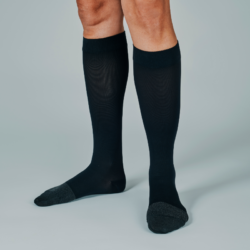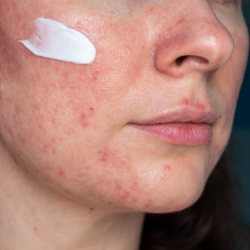In my article on rosacea, I told you about the structure and different roles of the skin. Today, I’m going to reveal my little secrets to repair and strengthen your skin barrier. Indeed, products not adapted to your skin type can sensitise it. In fact, it is important to learn how to build a routine adapted to your skin type. In addition, it will allow you to face all the small aggression of everyday life and avoid chapping, for example!
What is the skin barrier?
Different layers make up our skin; the skin barrier being the outermost of them. This protective film has two main functions: The first is to keep good things inside (fatty acids for example, or water) and the second is to prevent bad things from entering (such as irritants in the environment). When the skin barrier works at its best, it performs all its functions: The skin is then hydrated, soft and plump. On the other hand, when this same barrier is damaged, it’s a different story! It is difficult for it to function properly. In these conditions, the skin becomes dull, dry or flaky.
How to recognise a compromised skin barrier?
When your skin barrier isn’t working properly, you may be more prone to developing the following skin symptoms and conditions:
- Dry and flaky skin (when you get a sunburn, for example!)
- Itching
- Rough or discoloured spots
- Acne
- Sensitive or inflamed areas
- Bacterial, viral or fungal skin infections
What cleanser should I use so as not to aggravate the condition of my skin barrier?
Let’s start with skin cleansing. I regularly use several products when a person has a compromised skin barrier. For example, the Toleriane cleansing treatment from La Roche Posay. Indeed, this cleanser has been specially designed for reactive and irritable skin. Its composition is very minimalist: It contains only eight ingredients, including water.
However, if your skin is extremely sensitive, you can set aside your morning cleansing for a little while. Therefore, a simple rinse with water may be enough. There is also Avène’s Extreme Tolerance cleansing milk, which has similar properties. Indeed, its formula benefits from Sterile Cosmetic technology: a new and unique standard in the world, making it possible to manufacture formulas free of any form of preservative. In addition, its properties and effectiveness do not deteriorate over time.
Which make-up remover should I choose for my sensitised skin?
Rule number 1: Limit the number of products that come into contact with the skin. Indeed, it limits the chances of irritation.
For eye and face make-up removal, I generally advise using Bioderma Créaline Anti-Redness micellar water. However, it is important to always rinse it with warm water. Indeed, micellar waters tend to leave residues that can become sensitising. Jojoba oil is also interesting as an effective and very natural make-up remover. Apply to a damp cotton pad, before switching to your usual cleanser.
However, if your skin can no longer stand any cleanser, it is better to turn to an ultra-minimalist formula. Indeed, La Roche Posay offers a make-up remover that cleanses, removes make-up and soothes instantly. And this, without friction! Its composition is very simple since it contains neither perfume nor irritant. In addition, its sterile single-dose format is convenient to take anywhere.
Which cream should I use to boost my skin barrier?
When it comes to my favourite moisturisers, I love Avène’s extreme Tolérance emulsion. Its formula, consisting of just six ingredients, helps protect the skin microbiome.
I also like SVR’s Topialyse barrier cream. Indeed, it is very rich in essential fatty acids and peptides repairing the skin barrier. The Bioderma laboratory also has a miracle product, which acts on each stage of epidermal reconstruction. Indeed, this cream quickly relieves feelings of discomfort. It also offers optimal hydration, while ensuring perfect healing of the skin. Panthenol ceutic as well as Regen ceutic, are excellent care options for weakened skin.
Do I need to protect myself from the sun?
The next step is to use a broad-spectrum sunscreen, every day. Indeed, the sun’s rays intensely heat the skin, causing irritation, redness and discomfort. UVA and UVB rays then cause oxidative stress. In other words, micro-inflammation. This causes blood vessels to dilate and pain signals to be sent through nerve endings. In addition, the sun dries out the upper layer of the skin, destroying the skin barrier by exposing it to external aggression.
UV rays combine with pollution particles to produce an oxidising effect that further exacerbates oxidative stress and skin irritation. In the long term, UVA rays can increase skin sensitivity and dull skin tone. In fact, when the skin barrier is compromised, it is best to turn to the mineral sun protection. Indeed, mineral sunscreens are much better tolerated by atopic skin, unlike ‘chemical’ sunscreens.
My favourite products Care and nature
Here is the non-exhaustive list of products that can help you repair and strengthen your skin barrier:
- Omega 3: Consuming oils rich in omega 3 fatty acids has the potential to improve skin barrier function.*
- Evening primrose and borage oil.
- Prebiotics.
- Probiotics.
- Zinc.
- Radiant skin of Biocyte.
FAQ
- What is the skin barrier?
The skin barrier is the outer layer of skin that protects our body from external aggression, such as bacteria, viruses, allergens and irritants. It also helps maintain skin hydration by preventing excessive water evaporation.
- What are the main components of the skin barrier?
The skin barrier is mainly composed of dead skin cells (corneocytes) and lipids (fats), which work together to protect the skin from external aggression and maintain its hydration.
- How does the skin barrier work?
The skin barrier functions as a ‘wall’ that protects the skin from external aggression. Corneocytes and lipids form a compact, airtight structure that prevents harmful substances from entering the skin, while maintaining skin hydration by preventing excessive water evaporation.
Sources:
- https://www.ncbi.nlm.nih.gov/pmc/articles/PMC5595600/
- https://www.ncbi.nlm.nih.gov/pmc/articles/PMC3519246/
- https://www.ncbi.nlm.nih.gov/pmc/articles/PMC4466520/
- https://www.ncbi.nlm.nih.gov/pmc/articles/PMC5664322/
- https://www.ncbi.nlm.nih.gov/books/NBK537164/
- https://www.ncbi.nlm.nih.gov/pmc/articles/PMC6824628/
- https://www.ncbi.nlm.nih.gov/pmc/articles/PMC7875671/#b65-dp1101a132
- https://www.researchgate.net/publication/342941132_Atopic_dermatitis_and_the_role_of_zinc_in_maintaining_skin_barrier_properties







